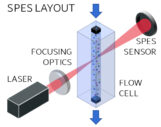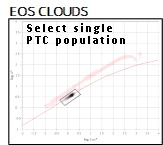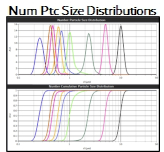EOS particle analysers are based on patented Single Particle Extinction and Scattering (SPES) method, a step forward in the way light scattering is exploited for single particle characterization of particle mixes in fluids as heterogeneous liquids and aerosol. SPES and dedicated data analysis algorithms provide more reliable and meaningful information, boosting R&D – QC processes, during lab scale design, industrial production, and advance monitoring of particles in biological, industrial, and environmental fluids. Added-value information is provided thanks to SPES and EOS Classizer™ family unique data and analysis libraries:
- Particle Optical Classification, Absolute Particle Size Distribution, Numerical Concentration of each single population irrespectively of polydispersity/composition.
- Quality Control of particle porosity, wetting, aspect ratio, payload, impurities, scraps, and shelf-life without intermediate steps (purification/filtration).
- Measurement of particle behavior and formulation stability directly in real heterogeneous non-filtered target biological, industrial, or environmental fluids.
- Hi-Resolution Continuous Flow Analysis, also coupling SPES information with other analytical devices as cFFF separators, small chemical reactors, and pilot line.
- Statistical approaches as Oversize Measure and PCA for Hi-Quality Batch-2-Batch analysis and out-of-specifics identifications in product formulation and production.
How Does SPES Work in Brief?

The patented Single Particle Extinction and Scattering (SPES) method is based on a self-reference interferometric measurement of the scattered wavefront in the forward direction by a single illuminated particle. Particles are driven by a laminar fluid flow (liquid or gas depending on the application/Classizer™ version) through the waist region of a tightly focused laser beam.

The intense transmitted beam interferes with the faint scattered wavefront in the far field, thus superimposing the two waves with the same curvature. This causes the interference pattern to exhibit intensity modulations on the spatial scale of the beam itself. Two scattering features are sampled to follow the evolution of the intensity modulations during the passage of each single particle through the beam: i) the global attenuation given by the particle which removes a small fraction of the incoming power; ii) the fringes given by the partial constructive and destructive interference, proportional to the amplitude of the complex forward adimensional scattered field S(0). These two features are directly related to the real ℜe S(0) and the imaginary ℑm S(0) components of S(0), as stems from the Optical Theorem [H. C. van de Hulst, Light Scattering by Small Particles, 1981].

The Extinction Cross Section ℜe S(0) = Cext* = k2/4π Cext and the Polarizability ℑm S(0) = α* = k3 α , where k = 2πn∕λ is the wave number in the medium n at wavelength λ, are retrieved for each single detected and counted particle thanks to a robust Pulse Shape validation scheme and proprietary algorithms, without adopting ill-posed problems like the inversion or deconvolution (note: other optical parameters could be alternatively retrieved, as particle optical thickness ρ). In a few minutes SPES creates the unique EOS CLOUDS histogram which is the optical fingerprint of the sample. A mix of particles produces simultaneously different clouds for each particle population, which can be individually selected, analysed, and compared.

Particle size distribution, numerical concentration, oversize, and other statistical insights are retrieved accordingly to the selection, to the whole sample, or for each time frame acquired in Continuous Flow Analysis mode. Statistical approaches as Principal Component Analysis are furthermore viable to extract unique information typically inaccessible nowadays.

